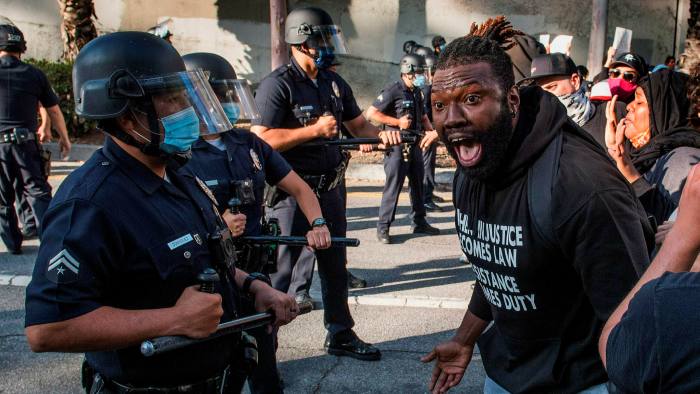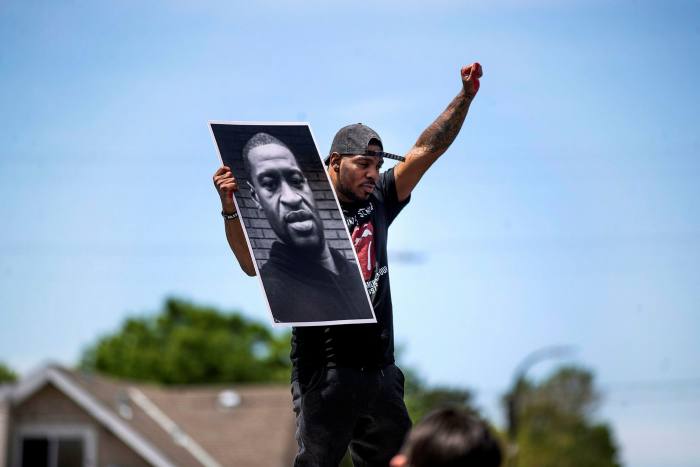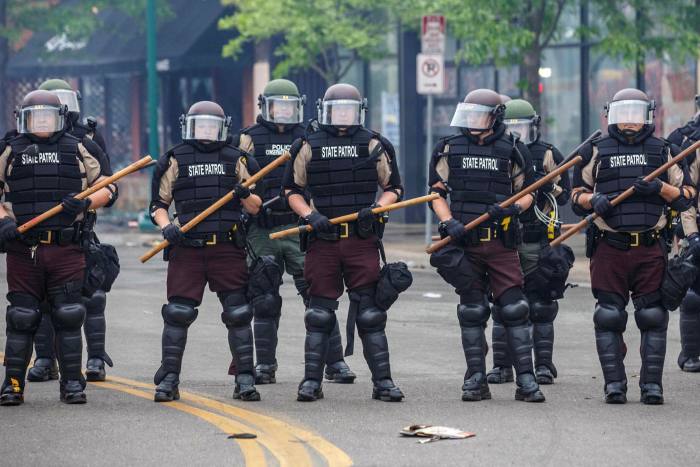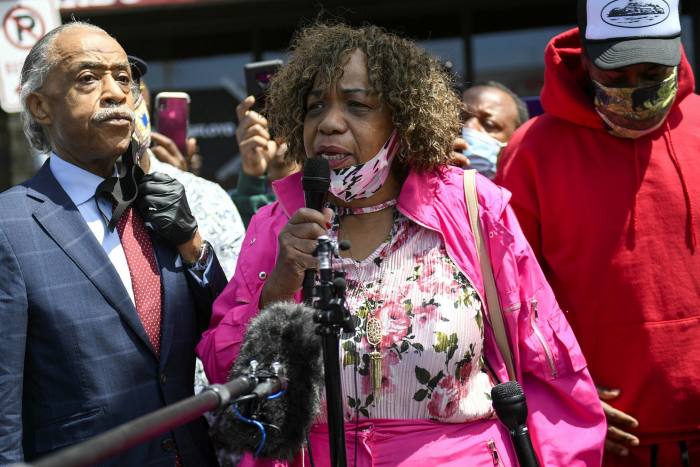
Public unrest across US reopens long-simmering divisions
George Floyd’s death echoes past killings of African-Americans
by Kadhim ShubberGeorge Floyd’s final words were chillingly familiar. As a white police officer in Minneapolis knelt on his neck for almost eight minutes on Monday, he said, “I can’t breathe” — the same phrase uttered by another African-American man, Eric Garner, who died after being placed in a police chokehold in New York in 2014.
The man who knelt on Floyd’s neck was arrested on Friday on murder charges — but only after days of protests and riots that returned issues of racial justice to the forefront of US political debate. Demonstrators set a Minneapolis police precinct on fire, and protests took place as far away as New York and Los Angeles.
The return of public unrest over deaths of African-Americans in police custody came as the US gears up for the 2020 presidential election in the midst of the coronavirus pandemic, which has killed more than 100,000 and disproportionately affected black and brown Americans who are generally more likely to have lower incomes and live in big cities.
“Generations of pain is manifesting itself in front of the world,” said Tim Walz, governor of Minnesota, which counts Minneapolis as its biggest city. “These are things in this country that have been brewing for 400 years.”
People are torn and hurt, because they’re tired of seeing black men die constantly, over and over againPhilonise Floyd, the brother of George Floyd
Donald Trump, the US president, added fuel to the fire on Friday as he raised the spectre of military action against protesters in Minnesota’s biggest city — employing a phrase used by a US police chief during the widespread racial unrest of the 1960s.
“Just spoke to Governor Tim Walz and told him that the military is with him all the way. Any difficulty and we will assume control but, when the looting starts, the shooting starts,” Mr Trump tweeted.
“When the looting starts, the shooting starts,” was the explanation offered in 1967 by Walter Headley, the chief of police in Miami, to explain why his city had not seen unrest in its black neighbourhoods.
Twitter hid Mr Trump’s tweet, and the subsequent tweet by the White House repeating the president’s comment, saying the language in the tweets violated its rules about “glorifying violence”.
Mr Trump later said the phrase was “spoken as a fact, not as a
statement,” saying that he was merely referring to the violence that
occurs during riots. He pointed to the shooting and killing of a man
in Minneapolis on Wednesday night.
The death of Floyd, 46, on Monday differed from similar cases in recent years because the graphic details were captured on video by a bystander. The footage circulated online, sparking bipartisan political outrage, federal and state criminal investigations and an outburst of anger that recalled the 2014 unrest in Ferguson, Missouri, where riots occurred for almost two weeks after Michael Brown was shot and killed by a police officer.

In the 10-minute video of Floyd’s final moments, officer Derek Chauvin does not remove his knee for almost eight minutes, long after Floyd, handcuffed and laying face down in the street, appears to be unresponsive. Pleas from onlookers are ignored. A second officer stands close by.
Mr Chauvin eventually moves to allow medical officers to place Floyd on a stretcher. He was declared dead in hospital. Footage from another angle showed two other officers had been pinning down the lower part of Floyd’s body.
Mr Chauvin was taken into custody on Friday and charged with third-degree murder and manslaughter, Minnesota prosecutors said.
“My vocabulary is not even large enough to tell you the depth of my feeling and outrage,” said John Gordon, executive director of the Minnesota branch of the American Civil Liberties Union. “You can see the life drain out of him [Floyd]. You can see it on the video.”
The Minneapolis police department said Floyd’s death came after they responded to a 911 call reporting the attempted use of a forged banknote. In a statement at the start of the week, the department said Floyd had “physically resisted officers”, a claim contradicted by surveillance footage from a nearby restaurant that raised further questions about the nature of policing in the US.

Floyd’s death drew condemnation from across the US political spectrum. Before his comments on using the military, Mr Trump ordered the Department of Justice to investigate and said the video was “a very shocking sight”. Joe Biden, former vice-president and Mr Trump’s Democratic rival in the 2020 presidential election, said Floyd’s death was not “an isolated incident” but part of a “systemic cycle of injustice”.
Mr Chauvin and three other officers involved in Floyd’s arrest were fired by the Minneapolis police department on Tuesday, but that action failed to quell calls for arrests. “Why is the man who killed George Floyd not in jail?” said Jacob Frey, the mayor of Minneapolis, on Wednesday.
In the Garner case, the police officer who tried to arrest him, Daniel Pantaleo, faced no charges, state or federal. Last year, the DoJ said it could not prove that Mr Pantaleo wilfully used excessive force against Garner to violate his civil rights. Mr Pantaleo was fired over Garner’s death in 2019.

Data on the number of Americans killed by the police each year is not published by the federal government, but efforts by news outlets and other groups to collate such figures suggest that about 1,000 people die at the hands of the police each year.
In Minneapolis, relations between the police department and minority communities have long been strained by incidents in which people have been shot and killed by officers or died in custody, as well as by racial disparities, common across the US, in how officers make arrests.
A 2015 ACLU study found that black residents of Minneapolis were “8.7 times more likely than whites to be arrested for a low-level offence”. A local news report that year, which cited official police data, found that just 5.4 per cent of Minneapolis police department officers lived in the city.
“It often feels like a remote relationship, an us and them relationship,” said Perry Moriearty, an associate professor at the University of Minnesota Law School, who gave testimony before the Minnesota legislature this year on racial disparities in the criminal justice system.
Recommended
AnalysisThe Big Read
US policing: Being black and blue
Medaria Arradondo, the chief of the Minnesota police department, apologised to Floyd’s family on Thursday as he appealed for calm. Mr Arradondo, who was appointed in 2017 as the first black police chief of the department, admitted there was “a deficit of hope” in the city.
“I know this department has contributed to that deficit of hope,” he said, urging protesters not to add to that deficit with further violence.
Floyd’s brother, Philonise Floyd, in an emotional appearance on CNN on Thursday said: “I want everybody to be peaceful right now, but people are torn and hurt, because they’re tired of seeing black men die constantly, over and over again.”